Teacher's guide
Table of Contents
- Objective
- Engaging Youth
- Planning a Get the Facts Lesson
- Additional Resources
- Get the Facts Lesson Guide
- Teacher’s Notes Legend
- Post-Module Survey
Objective
The goal of this presentation is to provide teachers with resources to help their grade 4 to 6 students understand the risks of substance use. The program includes:
- Basic information about alcohol, cannabis, tobacco and vaping products;
- Their short- and long-term effects;
- Information about addiction, stigma, and peer pressure; and
- Ways to protect mental and physical health.
It also includes some interactive activities to keep students engaged.
This page aims to provide you with tips and tools to host your own Get the Facts lesson.
Engaging youth
This program provides everything needed to build your own Get the Facts lesson, including a slideshow, speaking notes, and additional resources. The materials deliver fact-based information, thought-provoking activities, and tools to help your students make healthy choices.
Here are some tips to help you engage with your students in a way that promotes open and positive communication:
- Active listening: Ask open-ended questions, encourage discussion and let them know you hear them.
- Get in the right frame of mind: Understand their perspective.
- Respond clearly: Answer their questions.
- Be straightforward: Let them know your intent.
- Be calm: Offer a relaxed, judgement-free zone.
To learn about more strategies for talking to youth about substances, see Talking with teenagers about drugs and alcohol and Talking with your kids about cannabis.
Planning a Get the Facts lesson
Estimated duration: Approximately 60–90 minutes
| Introduction | (2-5 mins) |
| Types of Substances | (15-20 mins) |
| Healthy Heroes | (5-10 mins) |
| Effects of Substances | (10-15 mins) |
| Addiction | (5-10 mins) |
| Mental Health | (5-10 mins) |
| Peer Pressure | (5-10 mins) |
| Additional Resources and Q&A | (5-10 mins) |
Things to consider
- Location: This program can easily be done from your regular classroom. For home learning, students should find an area in their home where they are comfortable.
- Technical requirements: You will need internet access and a projector or large monitor to share the module content for the class.
- Students with access to individual computer, tablet or mobile devices will be able to engage with the interactive content on their own screens.
Additional resources
Do your students still have questions about alcohol, cannabis, tobacco, or vaping products? Continue the conversation with these resources, available for teachers, guardians and students:
Get the Facts lesson guide
Before getting started, please ensure you have the following:
- The Get the Facts slides are set up and visible to the students.
- Students have access to a computer or tablet (if available) so they can engage in the interactive activities such as trivia and two learning games.
Learning Games
Choose between printing and following along in class or having students participate on devices. There are two learning games that can be played following the presentation:
Healthy Heroes
Follow the Healthy Heroes as they encounter these substances while trying to save the city from the evil Dr. Disarray. Students will learn about the effects of cannabis, alcohol, tobacco, and vaping on the brain and the body.
Pressure Points
The Pressure Points activity provides students with strategies for handling peer pressure scenarios.
Teacher's notes legend
| Directions are outlined in light blue |
Post-module survey
Thank you for participating in Health Canada’s Get the Facts teacher-led module. We hope you found the content and its delivery informative for your students.
We would love your feedback on the module! Please take a few minutes to fill out the Teacher Feedback Survey.
Health Canada also offers other programs on substance use, including:
Find out more at HealthCanadaExperiences.ca.
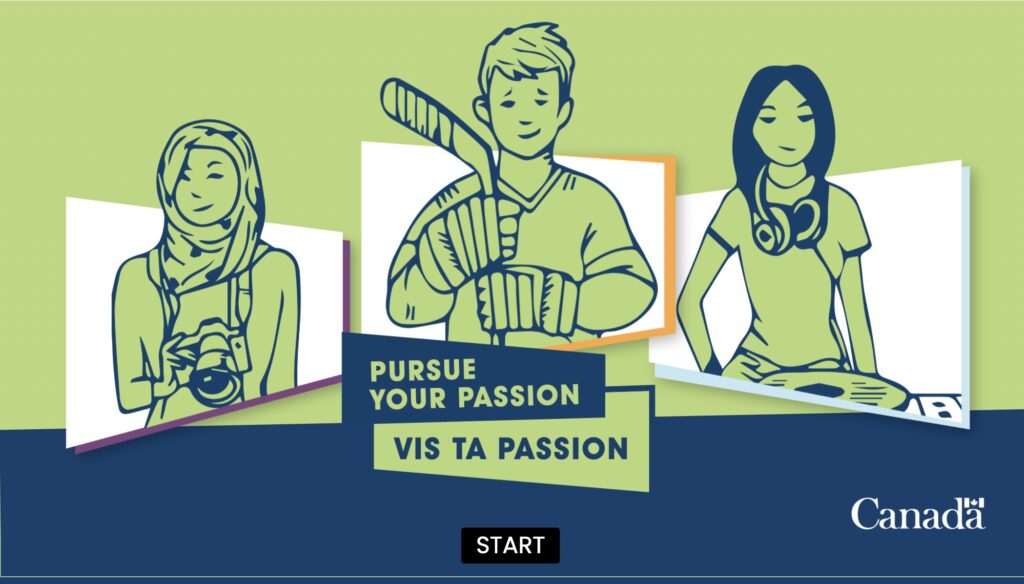
Teacher's Notes
“Did you know that youth and young adults who consume cannabis, especially cannabis containing THC, are more likely to experience mental health problems?
This happens because cannabis can interfere with healthy brain development until your mid 20s.
Youth and young adults who use cannabis are more likely to experience long-term mental health problems including cannabis dependence or cannabis use disorder, anxiety, depression, and even schizophrenia in those who have a family history.”
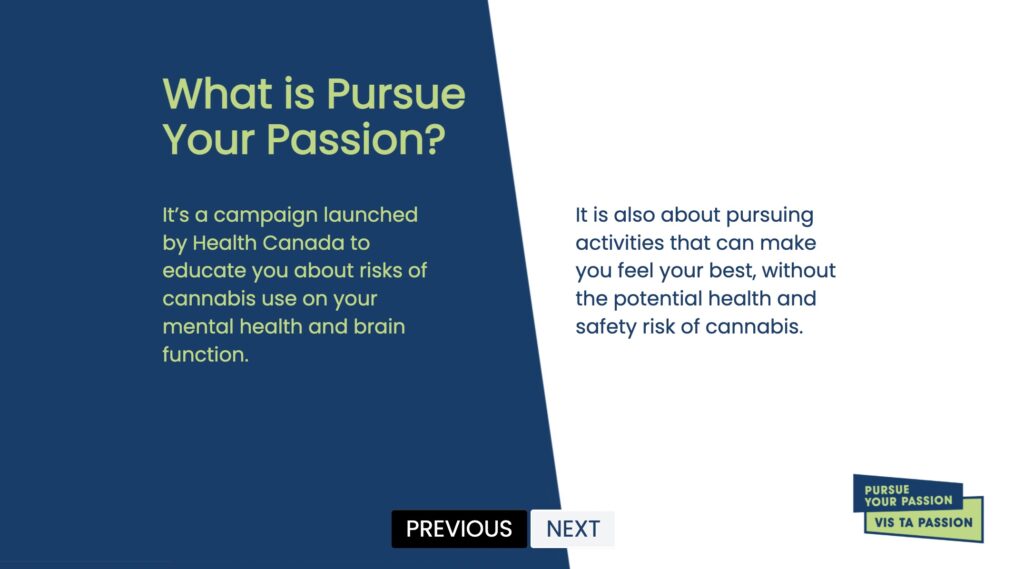
Teacher's Notes
“What is Pursue Your Passion? It’s a campaign launched by Health Canada to educate you about risks of cannabis use on your mental health and brain function.
It’s also about pursuing activities that can make you feel your best, without the potential health and safety risks of cannabis.”
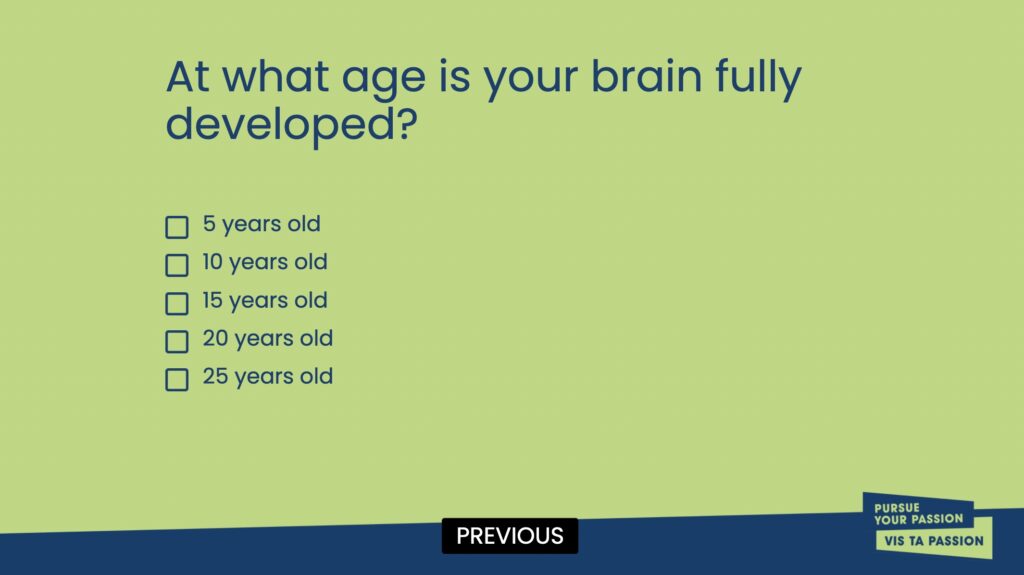
Teacher's Notes
“Let’s start with a pop quiz: At what age is your brain fully developed? 5 years old, 10 years old, 15 years old, 20 years old or 25 years old?”
(Ask students to shout out what they think the correct answer is. Submit the most popular answer on behalf of all the students.)
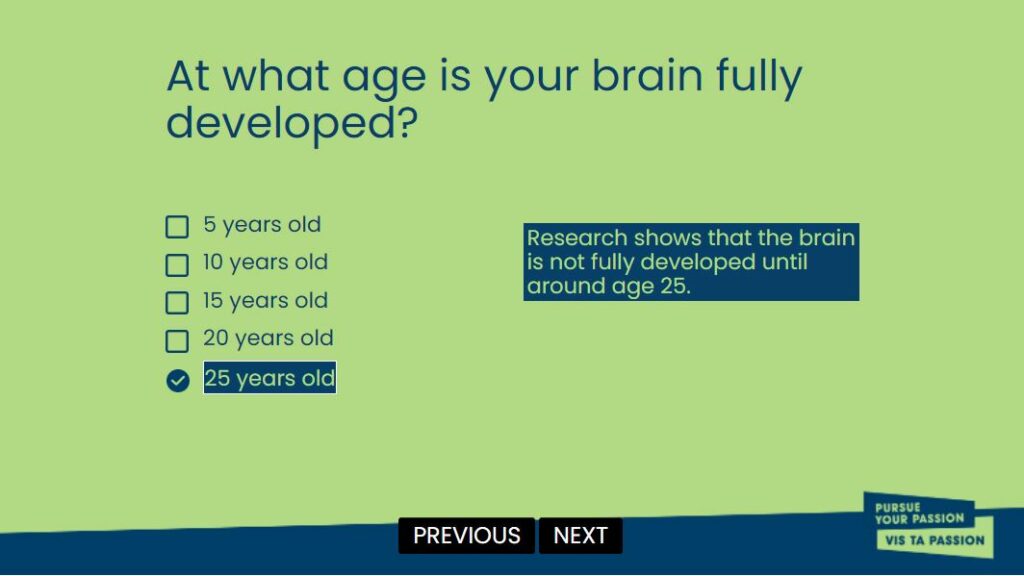
Teacher's Notes
“The correct answer is 25 years old. Research shows
that the brain is not fully developed until around age
25. Youth are especially vulnerable to the effects of
cannabis on brain development and function. The
earlier you start using cannabis, the more harm it
can do to your health.”
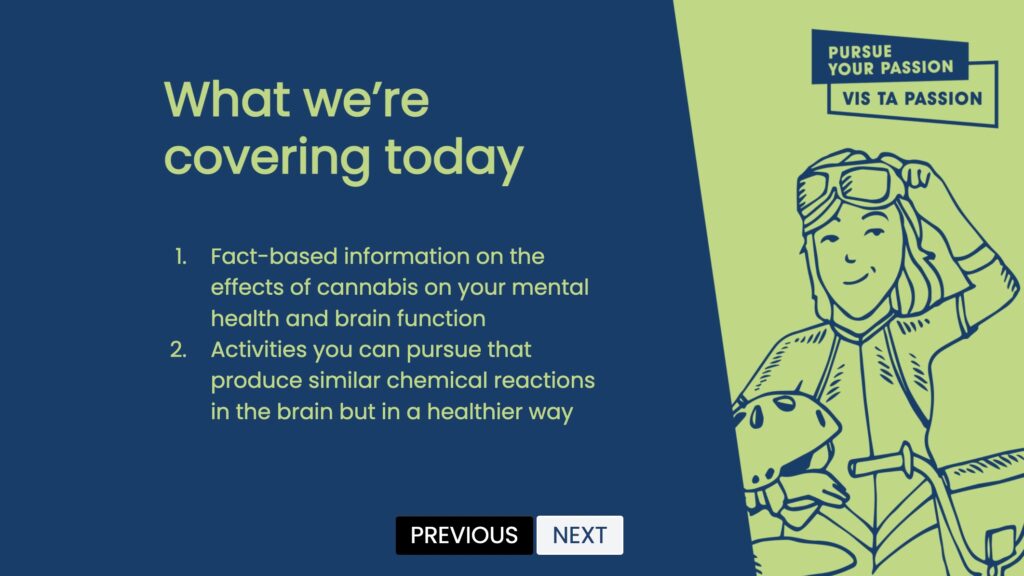
Teacher's Notes
“What we’re covering today
- Fact-based information on the effects of cannabis on your mental health and brain function
- Activities you can pursue that produce similar chemical reactions in the brain but in a healthier way”
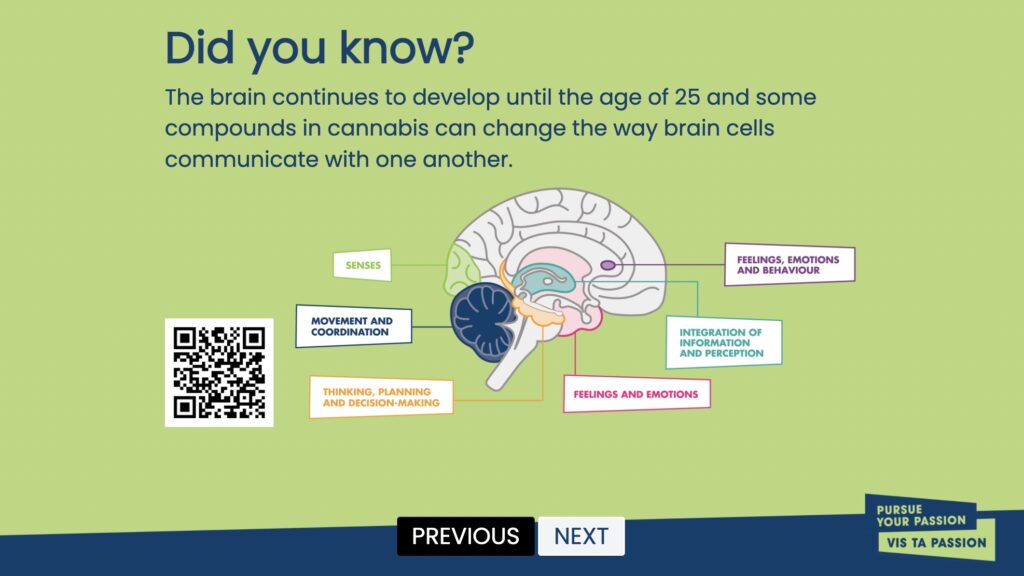
Teacher's Notes
“The brain continues to develop until the age of 25 and some compounds in cannabis can change the way brain cells communicate with one another.
Cannabis can impact different parts of the brain and can potentially impact the following long-term:
Your:
- Senses;
- Movement and coordination;
- Thinking, planning and decision-making;
- Feelings, emotion and behaviour;
- Information and perception
Let’s learn the facts on how cannabis affects each
area of the brain, and what could potentially happen
long term.”
(For more information visit: https://www.canada.ca/en/healthcanada/services/drugsmedication/cannabis/resources/cannabis-brainknow-facts.html)
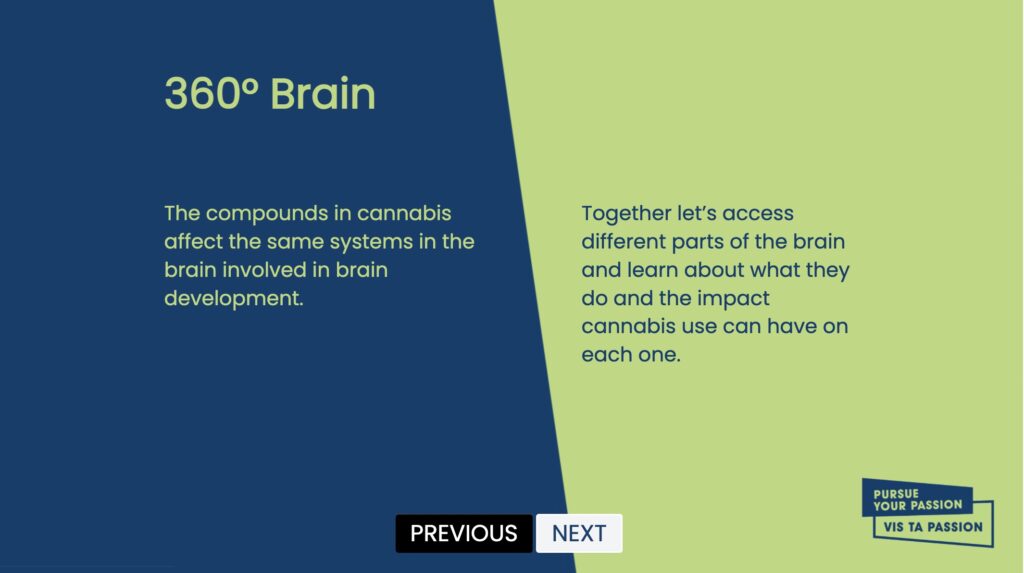
Teacher's Notes
“The compounds in cannabis affect the same systems in the brain involved in brain development.
Through the Pursue Your Passion experience, you can learn the facts on how cannabis affects each area of the brain, and what could potentially happen long term.
With the 360° Brain Education Tool, you will be able to access different parts of the brain and learn about what they do and the impact cannabis use can have on each one.
It is important to stress that frequent cannabis use can have a significant impact on youth and young adult brains, as the brain is still developing up to the age of 25.
Youth are especially vulnerable to the effects of cannabis on brain development and function.”
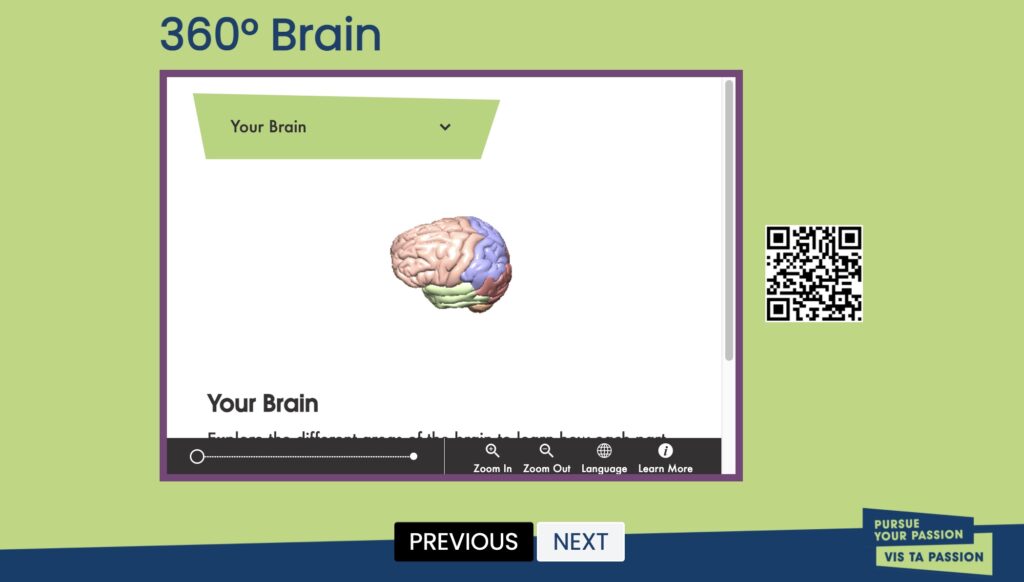
Teacher's Notes
“Here we will explore the different areas of the brain to learn how each part helps us all to function each and every day.
In this exercise we will focus on the areas of the brain that affect our thinking, planning and decision-making.
You can also scan the QR to take a look at the brain yourself.”
(Click on the dropdown and take the students through the Thinking & Planning sections. Read the info for each of the four sections in Thinking & Planning)

Teacher's Notes
“Pop quiz time…
What part of the brain registers and stores memories?
Frontal Lobe, Prefrontal Cortex, Corpus Callosum, or Hippocampus”
(Ask students to shout out what they think the correct answer is. Submit the most popular answer on behalf of all the students.)
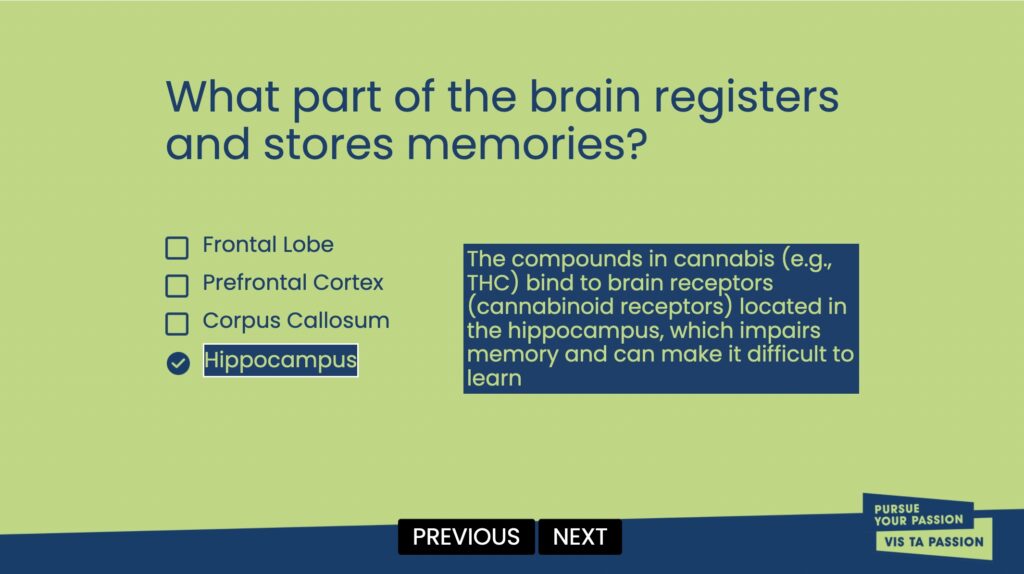
Teacher's Notes
“The correct answer is Hippocampus. The
compounds in cannabis (e.g., THC) bind to brain
receptors (cannabinoid receptors) located in the
hippocampus, which impairs memory and can make
it difficult to learn.”
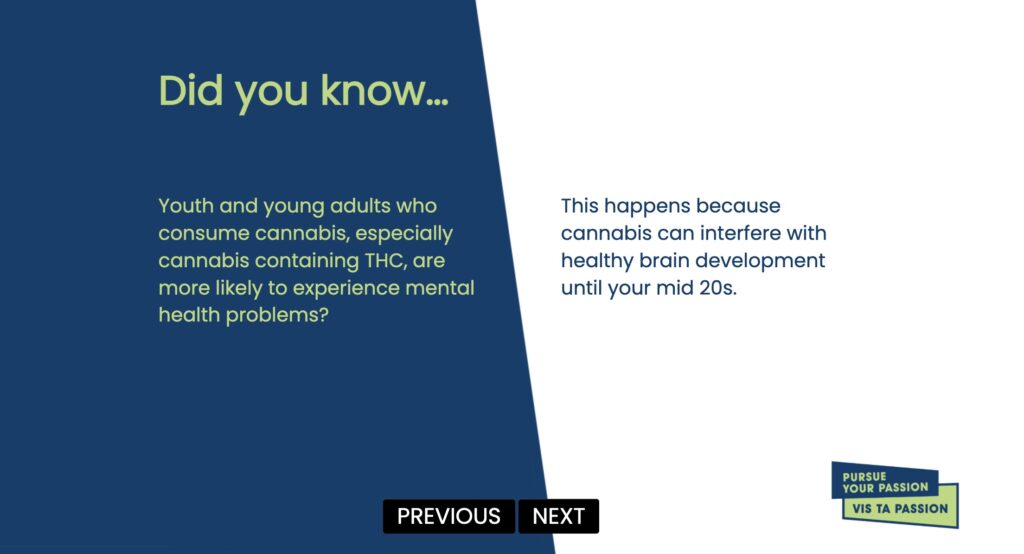
Teacher's Notes
“Did you know that youth and young adults who consume cannabis, especially cannabis containing THC, are more likely to experience mental health problems?
This happens because cannabis can interfere with healthy brain development until your mid 20s.”
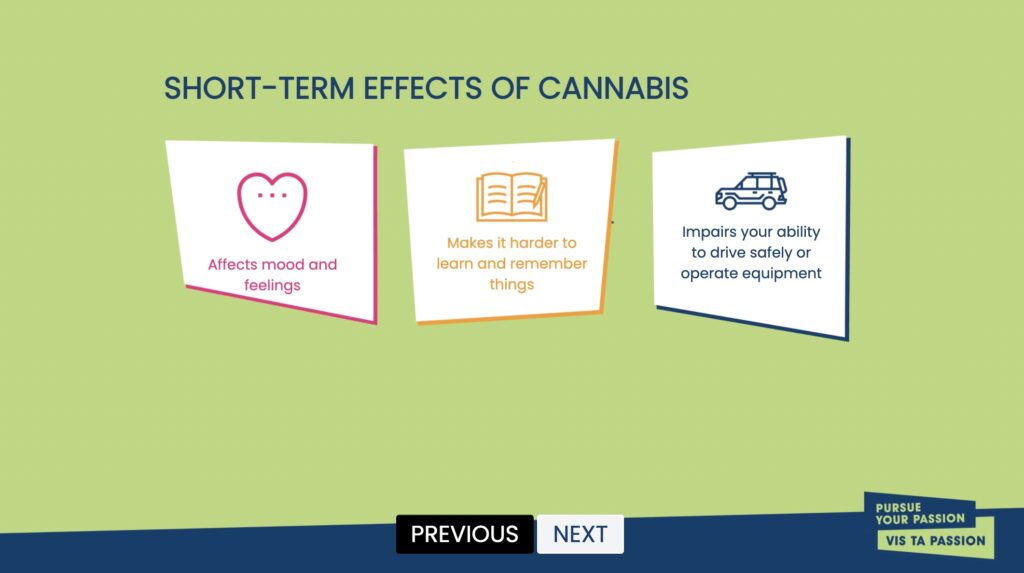
Teacher's Notes
“These are the short-term effects of using Cannabis”
Affects mood and feelings – While cannabis can make you feel relaxed and happy at times, it can also make you feel uncomfortable including feeling anxious, paranoid and depressed. Using cannabis products with higher THC levels (e.g., vape pens, shatter) can lead to greater levels of such negative effects.
Makes it harder to learn and remember things – After using cannabis, you may have problems paying attention, remembering or learning things, and making decisions. Using cannabis can reduce your ability to perform well on the job or at school.
Impairs your ability to drive safely or operate equipment – Driving is a complex task and requires the use of many areas of the brain. Cannabis can decrease your ability to react quickly, interferes with attention, and impairs coordination. If you know someone has consumed cannabis and intends to drive, do not get in a car with them.
Please consider a safer alternative to get yourself home. Call an Uber/ Lyft, taxi, or ask someone you trust to come and pick you up.”
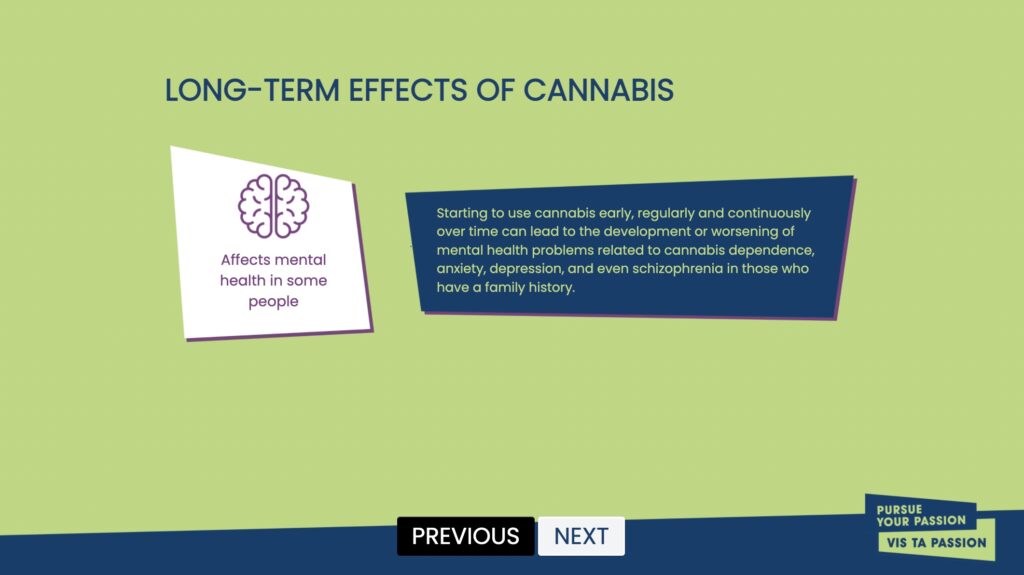
Teacher's Notes
“The long-term effects of using cannabis is that it affects mental health in some people.
Starting to use cannabis early, regularly and continuously over time can lead to the development or worsening of mental health problems related to cannabis dependence, anxiety, depression, and even schizophrenia in those who have a family history.”





